With a conversion rate of over 55%, 9 in 10 marketers consider webinars crucial for marketing.
57% of marketers host up to 50 webinars in a year to increase brand awareness, gather leads, and improve sales.
Get more detailed insights about webinars’ effectiveness, importance, and more in this statistical post.
Webinar Statistics 2024 (Top Picks)
- The average attendance rate for a webinar is between 20% to 40%.
- The average webinar conversion rate is around 55%
- 73% of B2B marketers say webinars are the best way to generate quality leads.
- 95% of businesses consider webinars as a critical part of their marketing strategy
- 44% of webinar attendees prefer a webinar to last 45 minutes
Webinar Attendance Rates
The webinar attendance rate varies according to industry and the topic. Let us take a look at the various average webinar attendance rates in this section.
The Average Attendance Rate For A Webinar Is Between 20% And 40%
There may be exceptions to this, and some webinars may have attendance rates as high as 50% or 60%, while some may have rates as low as 15%.
The average attendance rate for webinars with 100 to 199 registrants is 51%, and for webinars with 200 to 299 registrants, it falls to 18%.
However, the average attendance rate for Zoom webinars is 48%.
Source: Live webinar, Wistia.
Marketing Webinars Have An Average Attendance Of 44%
Marketing webinars usually have lower attendance rates and conversion rates.
The corporate communication webinars attract 65% attendance rates, while training webinars witness 53% attendance rates.
Here are further details about the average attendance rates recorded in different industries.
- Financial services: 61%
- Pharmaceutical industry: 61%
- Consulting: 50%
- Marketing webinars: 44%
- Corporate communications webinars: 65%
- Internal training webinars: 65%
Source: GoToWebinar
Webinar Conversion Rates
The conversion rates of webinars also vary according to your industry. This may decrease if people do not prefer the industry and topic you conduct the webinar on.
The Average Webinar Conversion Rate Is Around 55%
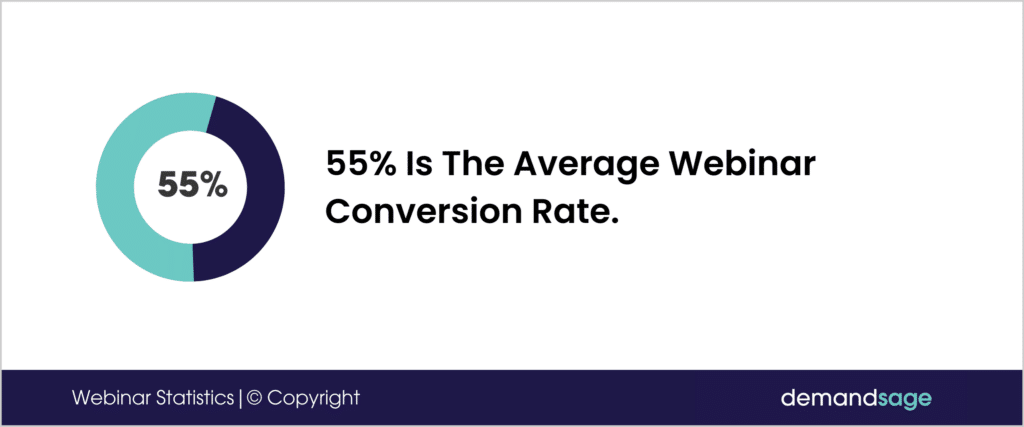
Webinars usually have higher conversion rates than other types of content.
However, it changes according to the industry, topic, and the number of attendees.
Creating a webinar that has well-structured and targeted content can help you turn interested attendees into paying consumers. Webinar is a powerful tool that helps drive sales and grow your business.
Here are further details about the average conversion rates recorded for webinars in different niches.
- Communication: 67.05%
- Training: 44.79%
- Marketing: 39.10%
- Education: 30.79%
Source: Cvent.
Webinars With Less Than 200 Attendees Have The Highest Audience Conversion Rate
The larger the webinar audience, the lower the attendance conversion rate.
Webinars with 100 to 199 attendees average a 50% conversion rate.
This number drops drastically as the audience builds. Here are further details about the conversion rates recorded with different numbers of attendees.
- 200 to 299 attendees:19% conversions
- 300 to 499 attendees: 15% conversions
- 500 to 599 attendees: 10% conversions
- 1,000+ attendees: 6% conversions
Source: Influno.
Webinar Engagement Statistics
Marketers use webinars to engage audiences with their content and brand. This helps them increase brand awareness, which makes it possible for the brands to reach high-potential clients.
This section covers the statistics related to the engagement of the audience with the webinar.
47% Of Webinar Views Come Within Ten Days After The Actual Event Of The Webinar
Keeping webinar content available even after the live events ensures reaching a larger audience and reduces the scheduling conflict.
Businesses make past webinars available on demand, as they have high potential returns.
24% of webinar views come 20 days after the event.
Here are further details about the views a webinar gets after an event.
| Time period | Views |
|---|---|
| Within ten days after the webinar | 47% |
| After 20 days | 24% |
| After 30 days | 10% |
Source: Actual Tech Media.
Wednesday And Thursday Are The Best Days To Host Webinars
28% of the total webinars are held on Thursdays, while 26% are held on Wednesdays.
The three days in the middle of the week account for 77% of the webinar experiences and have the highest attendance rates.
Mondays and Fridays are less ideal than mid-week, as people may be less engaged or busy with other priorities at the beginning or end of the workweek.
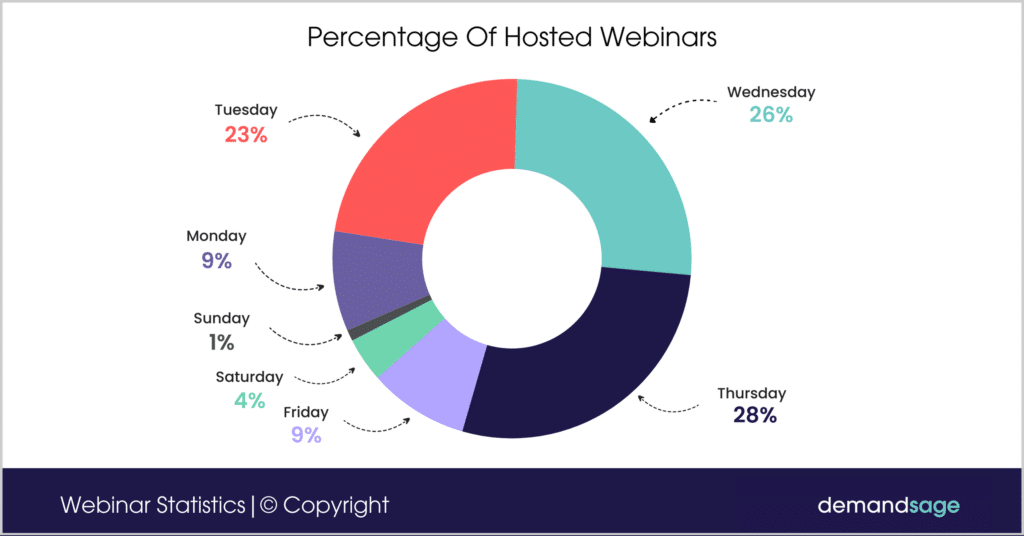
The following table displays the share of webinars that take place on different days of the week.
| Day of the week | Percentage of hosted webinars |
|---|---|
| Sunday | 1% |
| Monday | 9% |
| Tuesday | 23% |
| Wednesday | 26% |
| Thursday | 28% |
| Friday | 9% |
| Saturday | 4% |
Source: webinar.
Effectiveness Of Webinars
Over 9 in 10 marketers worldwide use webinars to find high-quality leads. Generally, the audience that is genuinely interested in a certain topic will spend their time attending a webinar, increasing the chances of lead generation.
95% Of Marketers Use Webinars As A Means To Generate Leads
95% of marketers see webinars as an important part of their marketing efforts. That is because they benefit from engaging in real-time with their potential leads.
Source: Contrast Webinars.
73% Of B2B Marketers And Sales Leaders Consider Webinars To Be The Most Effective Method For Generating High-Quality Leads
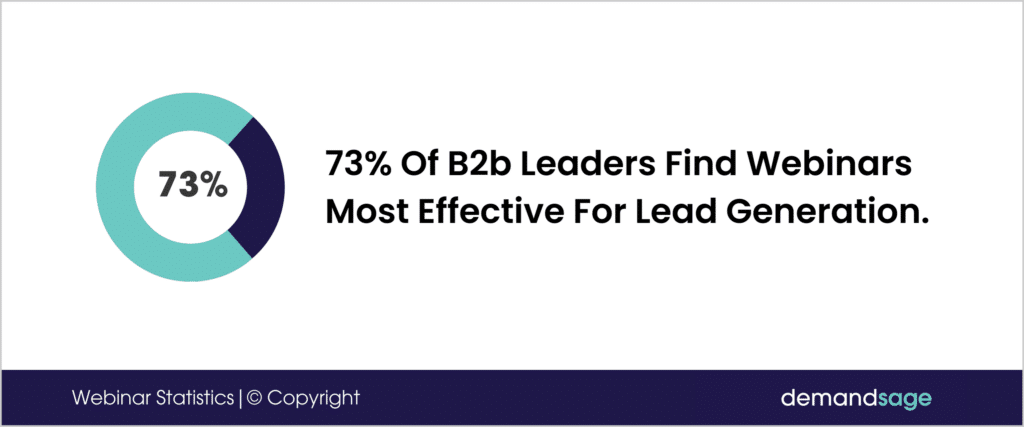
57% of the surveyed marketers said they would host more webinars this year.
By leveraging the usage of webinars, marketers can engage their target audience and provide them with valuable content, ultimately driving leads and potential sales opportunities.
Source: Outgrow.
99% Of Marketers Believe Webinars Represent A Critical Marketing Plan Element
Webinar is considered to be a significant part of the marketing plan. They help generate prioritized leads and decrease the cost per lead.
However, the effect of a webinar may change from industry to industry.
Here are further details about the views of the marketers about the usage of webinars in their marketing plan.
- Represent critical elements of a marketing plan: 99%
- Outperform other channels in creating qualified leads: 89%
- Help lower the cost per lead: 78%
- Have a direct impact on pipeline and revenue: 72%
- Leads are prioritized: 66%
Source: Statista.
29% Of The Webinars Are Organized By The Software And Technology Industry
Most of the seminars are hosted by companies and businesses in the software and technology industry, as they witness high success rates.
The financial services industry hosts the second-highest webinars share, with 14%.
On the other hand, only 1% of the webinars were hosted by nonprofit organizations. Most of their webinars aimed to spread awareness and were not a part of their marketing strategy.
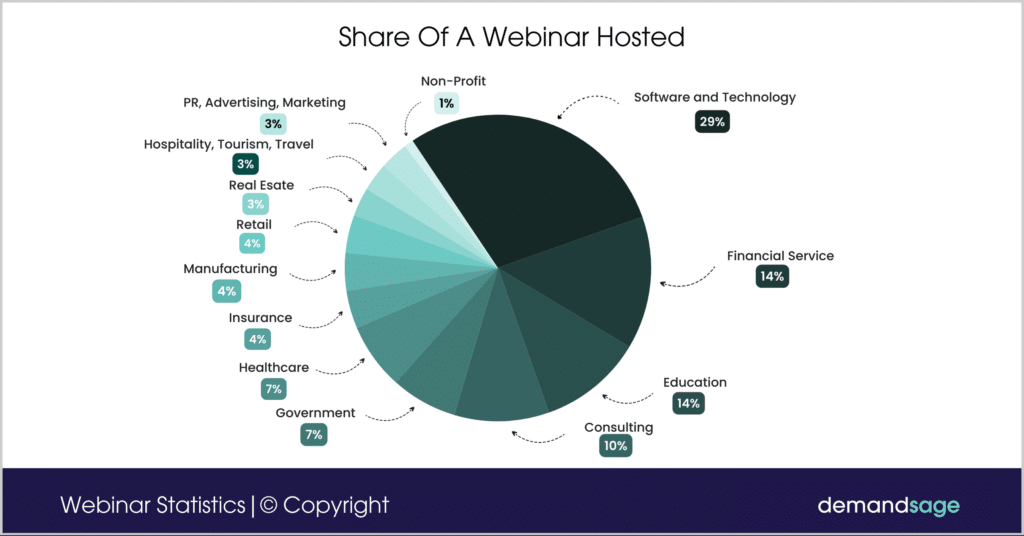
The following table details the share of webinars hosted by different industries.
| Industry | Share of a webinar hosted |
|---|---|
| Software and Technology | 29% |
| Financial Services | 14% |
| Education | 11% |
| Consulting | 10% |
| Government | 7% |
| Healthcare | 7% |
| Insurance | 4% |
| Manufacturing | 4% |
| Retail | 4% |
| Real Estate | 3% |
| Hospitality, Tourism, Travel | 3% |
| PR, Advertising, Marketing | 3% |
| Non-Profit | 1% |
Source: Go to Webinar.
51% Of Marketers Measure Webinar Success Through Demand Statistics Like Lead Quality
Nearly one-fourth of marketers consider generated lead quality to be one of the crucial measures of webinar success.
Meanwhile, 16% and 12% of marketers measure the success of the webinar through pipeline conversion rates and lead volumes, respectively.
Source: 99firms.
Webinar Length Statistics
Usually, businesses prefer to host a webinar for one hour, in which a session of 45 minutes is included, and the rest of the time is given to a Q&A session.
44% Of Webinar Attendees Prefer A Webinar To Last 45 Minutes
This is the ideal length for the webinar and a good benchmark when you are planning for your event.
Typically, the long webinars are split up into 45 minutes of lecture/ Information sharing followed by a short 5 to 10-minute question-and-answer section or a break.
Another 41% want them even shorter, at just 30 minutes long, while only 10% of the attendees wanted webinars that are actually 60 minutes long.
Source: Zippia.
The Average Webinar Is Around 60 Minutes Long
This length provides enough time for the presenter to cover the materials without overwhelming the audience. It also gives time for interactive segments so that the webinar does not include just one-sided speech.
A webinar lasting 60 minutes can be typically broken down into three sections as follows.
- 5 to 7 minutes: Welcome attendees and introduce yourself
- 38 to 45 minutes: Present on the core topic
- 10 to 15 minutes: Q&A session
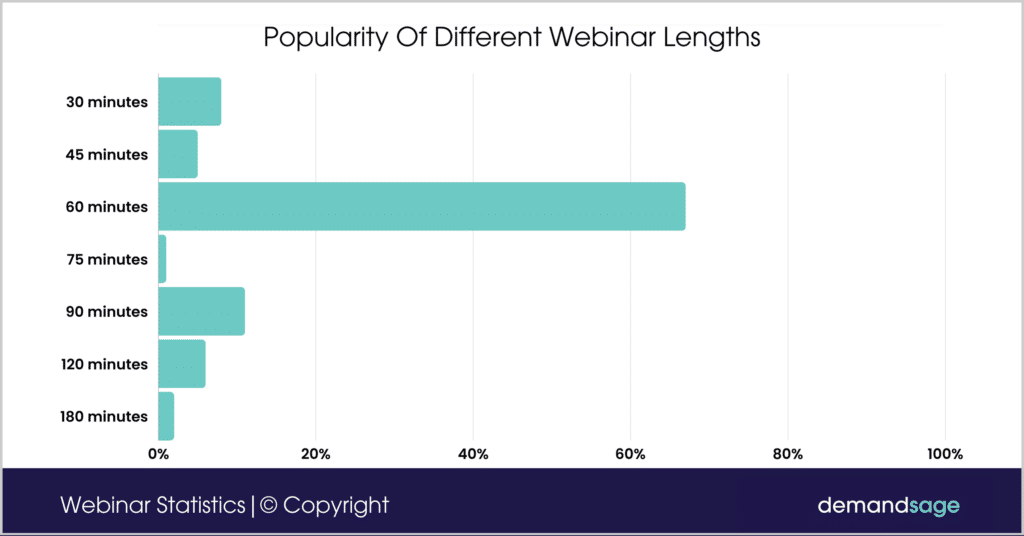
The following table displays the popularity of different webinar lengths:
| Webinar Lenght | Popularity |
|---|---|
| 30 minutes | 8% |
| 45 minutes | 5% |
| 60 minutes | 67% |
| 75 minutes | 1% |
| 90 minutes | 11% |
| 120 minutes | 6% |
| 180 minutes | 2% |
Source: eWebinar.
The Webinar Attendees Attend Only 42 Minutes Of The Webinar On Average If Its Length Is 1 Hour
Meanwhile, on average, the attendees attend the webinar for just 111 minutes if it is scheduled for 180 minutes.
The average viewing time for all types of webinars is 57 minutes. This is because the attention span of the attendees may last up to a max of 45 minutes or more. Hence, make sure to schedule your webinars accordingly.
The following table displays the average attendance length of attendees in a webinar of different lengths.
| Webinar Length | Average Attendance Length |
|---|---|
| 20 minutes | 14 minutes |
| 40 minutes | 28 minutes |
| 50 minutes | 35 minutes |
| 60 minutes | 42 minutes |
| 70 minutes | 49 minutes |
| 80 minutes | 56 minutes |
| 100 minutes | 64 minutes |
| 120 minutes | 73 minutes |
| 140 minutes | 89 minutes |
| 160 minutes | 96 minutes |
| 180 minutes | 111 minutes |
Source: Luisa Zhou.
Webinar Registration Statistics
The study shows that most webinar registrations come through the brand’s website or email campaigns.
This section covers details about the latest facts and figures about the webinar statistics.
76% Of People Register For Webinars By Email
80% of the marketers said they drive virtual event registers through their business websites.
Other popular methods that brought registrations for the webinar include social media and programmatic advertising.
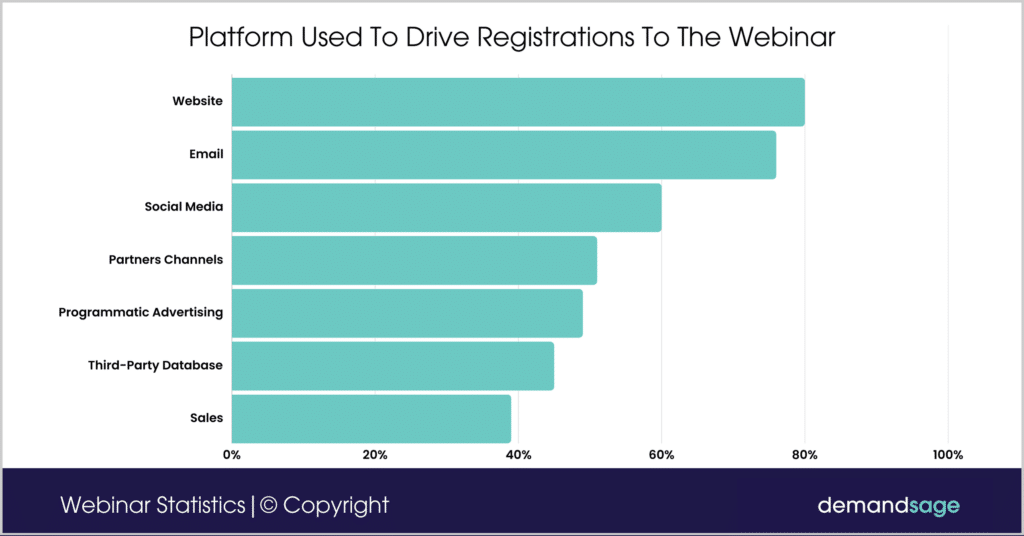
The following table displays the most popular means used to drive registrations for the webinars.
| Platform used to drive registrations to the webinar | Percentage of businesses |
|---|---|
| Website | 80% |
| 76% | |
| Social Media | 60% |
| Partners Channels | 51% |
| Programmatic Advertising | 49% |
| Third-Party Database | 45% |
| Sales | 39% |
Source: ON24, GoToWebinar.
29% Of People Register On The Same Day As The Webinar
Meanwhile, 15% of people register 15 days before the event.
59% of the people register for webinars when less than a week is left. This shows that the majority of the attendees register for the webinar within a week.
Further, 3 in 10 attendees register on the same day as the webinar.
The following table displays the percentage of registrations recorded in different time frames before the webinar.
| Time frame of registration | Percentage of registration |
|---|---|
| four weeks before the webinar | 12% |
| Between 2 to 4 weeks of webinar | 13% |
| Between 1 to 2 weeks of webinar | 16% |
| Less than a week | 59% |
Source: Webicare.
Webinar Content Statistics
The content of the webinar determines its success rate. Hence, the hosts curate the content of their webinars accordingly to engage the audience they want.
The webinar’s content also helps convert the leads into sales and keeps the audience hooked up to the last minute.
This section highlights some of the latest facts and figures about webinars.
81% Of The Webinars Include Q&A Sessions
Q&A sessions allow the audience to provide feedback, clear doubts, feel heard, and interact with the expert. Marketers also utilize the Q&A session to address their audience’s pain points and try to convert them into leads.
If the webinar includes a smaller audience, the experts can take questions live and on the go.
However, in a webinar with a large audience and time contractions, the audiences get to submit their questions. The host then segregates the questions and answers the most relevant ones during the webinar.
Source: Actual tech.
69% Of All Webinars Offer Resources For Attendees To Download And Engage With
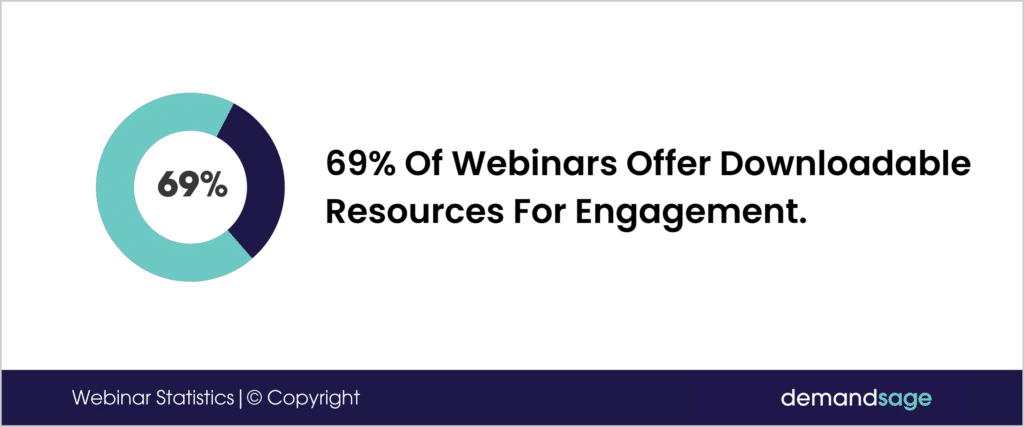
Two-way engagement is one of the key benefits of the webinars. Hence, the host must engage the audience to participate in each session’s conversation.
7 in 10 businesses said that they build webinars with interactivity in mind.
Here are further details about the content utilized by the hosts to create engagement among the audience.
| Content utilized to create engagement | Percentage of marketers |
|---|---|
| Q&A | 81% |
| Resources for download | 69% |
| Surveys | 36% |
| Social | 25% |
| Polling | 22% |
| Group chat | 10% |
Source: ON24.
61% Of B2b Businesses Use Webinars And Webcasts As A Content Marketing Tactic
It is the 10th most popular form of marketing content.
The webinars ranked below infographics, which are preferred by 62% of B2B marketers and above microsites.
The most used type of content for marketing is social media content.
Here are further details about the types of content marketing tactics preferred by B2B companies.
- Social Media Content: 92%
- Newsletters: 83%
- Website Content: 81%
- Blogs: 80%
- In-person Events: 77%
- Videos: 77%
- Illustration/Photos: 76%
- White Papers: 69%
- Online Presentation: 68%
- Infographics: 62%
- Webinars/ webcasts: 61%
- Research Reports: 48%
- Micro Sites: 47%
Source: Content marketing institute, blogging wizard.
